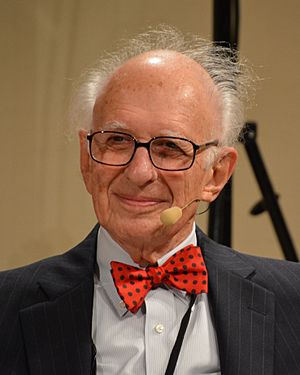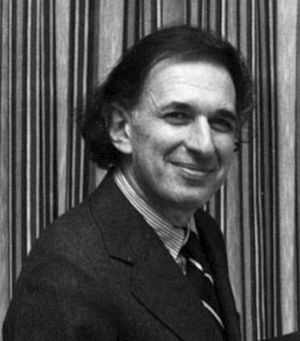Eric Kandel facts for kids
Quick facts for kids
Eric Kandel
|
|
|---|---|

Kandel in 2013
|
|
| Born |
Erich Richard Kandel
November 7, 1929 Vienna, Austria
|
| Education | Harvard University (BA) New York University (MD) |
| Known for | Physiology of learning and memory |
| Spouse(s) | |
| Children | 2 |
| Awards | Karl Spencer Lashley Award (1981) Dickson Prize (1983) Lasker Award (1983) National Medal of GSS (1988) Harvey Prize (1993) Wolf Prize in Medicine (1999) Nobel Prize in Physiology or Medicine (2000) |
| Scientific career | |
| Fields | Psychiatry, Psychoanalysis and Neuroscience |
| Institutions | Columbia University College of Physicians and Surgeons |
| Notable students | James H Schwartz Tom Carew Kelsey C. Martin Priya Rajasethupathy Scott A. Small Christopher Pittenger |
Eric Richard Kandel is an American medical doctor and scientist. He was born in Vienna, Austria, on November 7, 1929. He became a professor at Columbia University and is famous for his work on how our brains store memory.
In 2000, Eric Kandel won the Nobel Prize in Physiology or Medicine. He shared this important award with two other scientists, Arvid Carlsson and Paul Greengard. His research helped us understand how memories are made and kept in the brain's neurons (nerve cells).
From 1984 to 2022, Kandel was a Senior Investigator at the Howard Hughes Medical Institute. He also helped start the Center for Neurobiology and Behavior at Columbia University in 1975. This center is now the Department of Neuroscience. Kandel wrote a popular book about his life and research called In Search of Memory: The Emergence of a New Science of Mind. This book won an award in 2006.
Contents
Early Life and Education
Eric Kandel's parents, Charlotte and Hermann Kandel, were from parts of Austria-Hungary that are now in Ukraine. They moved to Vienna, Austria, where they met and married in 1923. Eric was born in Vienna in 1929. His father owned a toy store.
When Eric was nine years old, his family faced difficulties because of the political situation in Austria. In March 1938, Austria became part of Germany. Attacks on Jewish people increased, and their property was taken away. Eric and his older brother, Ludwig, left Austria in May 1939. They traveled to Brooklyn, New York, to live with their uncle. Their parents joined them later.
After settling in Brooklyn, Eric went to the Yeshiva of Flatbush and later to Erasmus Hall High School. He then studied History and Literature at Harvard University. While at Harvard, he became very interested in how people learn and remember things. He wanted to understand the connection between our thoughts (psychology) and our brain's biology (neurology).
In 1951, a teacher he admired passed away, leaving a space in his studies. Around this time, he met Anna Kris, whose parents were psychoanalysts. They were part of a group that worked with Sigmund Freud, a famous thinker who explored the unconscious mind. This sparked Kandel's interest in the biology behind motivation and memory. In 1952, he decided to study medicine at New York University.
Medical School and First Research
Eric Kandel started medical school at New York University Medical School in 1952. He was very keen on understanding the biological basis of the mind. During this time, he met his future wife, Denise Bystryn.
In 1955-1956, Kandel worked in a lab at Columbia University. He learned about using special tools to measure the electrical activity of nerve cells. Scientists at the time found it hard to study the tiny nerve cells in the human brain.
Kandel was inspired by another scientist, Stephen Kuffler, who studied nerve cells from sea animals. These cells were much bigger and easier to study. After medical school, Kandel learned how to use tiny electrodes to record electrical signals from the large nerve cells of crayfish.
A famous neuropsychologist, Karl Lashley, tried to find where memories were stored in the brain but couldn't. Then, in 1957, Kandel joined a lab at the National Institutes of Health. Other scientists had just found a patient, HM, who couldn't form new memories after a part of his brain, the hippocampus, was removed. Kandel decided to study the nerve cells in the hippocampus.
He found that these cells had electrical activity and could even create electrical bursts like those seen in epilepsy. However, he didn't find anything special about these cells that explained why the hippocampus was so important for memory.
Kandel then realized that memory must involve changes in the connections between nerve cells, called synapses. He thought it would be better to study a simpler animal to understand these changes. He believed that what he learned from simple animals could also apply to humans. This was a risky idea because many scientists thought human memory was too complex to learn from invertebrates.
In 1962, Kandel went to Paris to study a sea slug called Aplysia californica. He realized that simple forms of learning, like getting used to something (habituation) or becoming more sensitive (sensitization), could be studied easily in Aplysia. He could stimulate nerve pathways in the slug and see how the connections between cells changed. In 1965, Kandel published his first findings, showing how simple learning could change these connections.
Working at New York University
Kandel started working at the New York University Medical School. He created a new division focused on neurobiology and behavior. With his team, he showed how the sea slug's gill-withdrawal reflex could learn. This reflex, which helps the slug protect its delicate gills, could be trained to habituate (get used to a harmless touch) or sensitize (react more strongly to a touch after a painful one).
By 1971, his team began studying how these simple forms of learning could lead to long-term memory, not just short-term memory. By 1981, they showed that the Aplysia system could also be used to study classical conditioning, a more complex type of learning. This helped bridge the gap between simple learning in invertebrates and complex learning in vertebrates.
Kandel's lab mapped the nerve circuits involved in these learned behaviors. They found that learning changes how well existing connections between nerve cells work. This groundbreaking work with Aplysia led to Kandel winning the Nobel Prize in 2000.
Brain Changes During Learning
Starting in 1966, James Schwartz worked with Kandel to study the chemical changes in nerve cells during learning. They knew that long-term memory, unlike short-term memory, required the creation of new proteins. By 1972, they found that a molecule called cyclic AMP (cAMP) was produced in Aplysia when short-term memories were formed.
In 1974, Kandel moved his lab to Columbia University. They soon discovered that a brain chemical called serotonin helps produce cAMP, which is involved in making the gill-withdrawal reflex more sensitive. By 1980, they found that an enzyme called protein kinase A (PKA) was also important in this process. Another scientist, Steven Siegelbaum, found a channel in nerve cells that PKA could control, linking serotonin's effects to changes in nerve cell activity.
In 1983, Kandel helped create the Howard Hughes Medical Institute at Columbia, focusing on the molecular science of the brain. His lab then looked for proteins needed to turn short-term memories into long-lasting ones. They found that a protein called CREB (cAMP response element binding protein) was key for long-term memory. When CREB is activated, it increases the number of connections between nerve cells. This showed that short-term memory involves changes in existing connections, while long-term memory involves creating new connections.
Understanding How We Learn
Kandel's lab also did important experiments using special mice to study memory in vertebrates. Kandel's original idea that learning mechanisms are similar across all animals was proven true. The same types of brain chemicals, enzymes, and proteins involved in learning and memory in sea slugs are also found in vertebrates, including humans.
Ongoing Work at Columbia University
Since 1974, Eric Kandel has continued his scientific work at Columbia University. In 2008, he and Daniela Pollak found that training mice to associate a specific noise with safety could reduce their anxiety, similar to how antidepressant medicines work. This discovery, published in the journal Neuron, could help future studies on how medicines and behavioral treatments affect the brain.
Kandel is also well-known for the science textbooks he has helped write, such as Principles of Neural Science. This book, first published in 1981, is now in its sixth edition. It is widely used in medical schools and universities to teach about the brain. Kandel has been a member of the National Academy of Sciences since 1974. He lives in New York City.
Notable Students and Colleagues
Many talented scientists have worked in Eric Kandel's lab and gone on to have successful careers.
- James H. Schwartz: Co-author of the important textbook Principles of Neural Science.
- John H. (Jack) Byrne: Professor and director of a neuroscience research center.
- Tom Carew: Professor and Dean at New York University.
- Edgar T. Walters: Professor at the University of Texas.
- Kelsey C. Martin: Dean of the David Geffen School of Medicine at UCLA.
Views on Vienna
When Kandel won the Nobel Prize in 2000, some media called him an "Austrian" winner. Kandel felt this was not quite right, saying it was "certainly not an Austrian Nobel, it was a Jewish-American Nobel." He then received a call from the Austrian president, who asked how they could make things right.
Kandel suggested two main things. First, he wanted a street named after an anti-Semitic mayor, Karl Lueger, to be renamed. This street was indeed renamed in 2012. Second, he wanted to encourage Jewish students and researchers to return to Vienna through scholarships. He also proposed a meeting to discuss Austria's past actions during a difficult historical period. Kandel has since accepted honorary citizenship of Vienna and takes part in the city's academic and cultural life.
Awards and Honors
Eric Kandel has received many awards for his important scientific contributions:
- Fellow of the American Academy of Arts and Sciences (1976)
- Karl Spencer Lashley Award (1981)
- Albert Lasker Award for Basic Medical Research (1983)
- Member of the American Philosophical Society (1984)
- Gairdner Foundation International Award (1987)
- NAS Award for Scientific Reviewing (1988)
- National Medal of Science (1988)
- Pasarow Award (1988)
- Member of the German Academy of Sciences Leopoldina (1989)
- Harvey Prize (1993)
- Ralph W. Gerard Prize in Neuroscience (1997)
- Wolf Prize in Medicine (1999)
- Nobel Prize in Physiology or Medicine (2000)
- Charles A Dana Award for Pioneering Achievement in Health (1997)
- Austrian Decoration for Science and Art (2005)
- Benjamin Franklin Medal for Distinguished Achievement in the Sciences (2006)
- Viktor Frankl Award of the City of Vienna (2008)
- Honorary citizen of the city of Vienna (2009)
- Honorary doctor at the Norwegian University of Science and Technology (2011)
- Grand Decoration of Honour in Silver with Star for Services to the Republic of Austria (2012)
- Pour le Mérite for Arts and Sciences (Germany)
- Foreign Member of the Royal Society (2013)
- Elected Honorary Fellow of the Royal Society of Edinburgh (2018)
- Grand Decoration of Honour in Gold with Sash for Services to the Republic of Austria (2024)
Film and Books
- A film about his life and work, In Search of Memory, was released in 2008.
- Kandel, Eric R. (2018), The Disordered Mind: What Unusual Brains Tell Us About Ourselves, New York: Farrar, Straus and Giroux, ISBN: 9780374287863.
Images for kids
See also
 In Spanish: Eric Kandel para niños
In Spanish: Eric Kandel para niños



